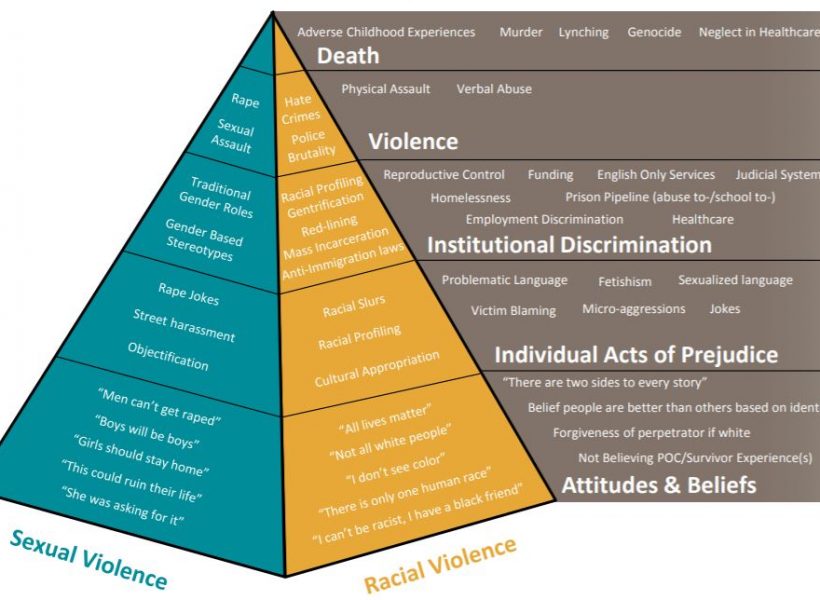“Systems of oppression give greater social power to some people over others based on race, gender, sexual orientation, ability, and other aspects of identity. Working towards a future without sexual violence means that advocates, survivors, and communities need to respond to a complex and layered reality that centers the needs of those survivors most marginalized, silenced, and unseen.”
– California Coalition Against Sexual Assault
INTERSECTIONALITY AS A FRAMEWORK FOR UNDERSTANDING SEXUAL VIOLENCE
We know that people of all genders can perpetrate or experience sexual violence, and people of all genders deserve to be believed and supported in their healing journeys. We also know that viewing sexual violence through a gendered lens allows us to see patterns that help us address the root cause of it. More specifically, the majority of people committing acts of sexual violence are men and the majority of people experiencing it are women.2
Beyond a gendered lens, intersectionality helps us understand the patterns of sexual violence even more clearly. It illuminates the reality that those who live at the intersections of multiple marginalized identities—like Indigenous women, women living with disabilities, or trans people of colour—experience sexual violence at higher rates.3 For example, women living with disabilities experience two times the amount of violence as women living without disabilities. Women living with disabilities who identify as lesbian, gay or bisexual, experience two times the amount of violence as women living with disabilities who identify as straight.4
Intersectionality also allows us to understand the barriers that people face when choosing to disclose or report their experiences of sexual violence. For example, Black women are less likely to report their experiences of sexual violence out of fear of not being believed or not having access to culturally competent resources,5 and men convicted of raping a white woman face harsher penalties than men convicted of raping a Black woman.6
The Consent and Sexual Respect Initiative is committed to supporting our BIPOC and LGBTQIA+ community. We hope to foster a more complete understanding of sexual violence prevention in connection with anti-racism and LGBTQIA+ equity. Sexual violence disproportionally impacts BIWOC and LGBTQIA+ communities, and one of our goals is to promote awareness of this reality and offer additional support services for these vulnerable populations.

Racial & Sexual Violence Pyramid
This graphic depicts the connection and overlap between racial and sexual violence. Attitudes and beliefs are the foundation that continues to uphold both individual acts of prejudice, and institutional and systemic discrimination, that contribute to violence and death. This is not an exhaustive list of examples but is a starting point to help others understand the connection.
References
1Crenshaw, Kimberle (1989) “Demarginalizing the Intersection of Race and Sex: A Black Feminist Critique of Antidiscrimination Doctrine, Feminist Theory and Antiractist Politics,” University of Chicago Legal Forum: Vol. 1989: Iss. 1, Article 8. Available at http://chicagounbound.uchicago.edu/uclf/vol1989/iss1/8
2Benoit, C., Shumka, L., Philips, R., Kennedy, M. C., Belle-Siel, L. (2015, December). Issue brief: Sexual violence against women in Canada. Status of Women Canada. https://cfc-swc.gc.ca/svawc-vcsfc/index-en.html
3Status of Women Canada (2020, October 10). About Gender-Based Violence. https://cfc-swc.gc.ca/violence/knowledge-connaissance/about-apropos-en.html
4VAW Learning Network (2019, January). Issue 27: Women with disabilities and D/deaf women, housing, and violence. http://www.vawlearningnetwork.ca/our-work/issuebased_newsletters/issue-27/index.html
5RAINN (2020, June 19). For many Black survivors, reporting raises complicated issues. https://www.rainn.org/news/many-black-survivors-reporting-raises-complicated-issues
6Tillman, S., Bryant-Davis, T., Smith, K., & Marks, A. (2010). Shattering silence: Exploring barriers to disclosure for African American sexual assault survivors. Trauma, Violence, & Abuse, Vol 11(2), 59-70. https://doi.org/10.1177/1524838010363717